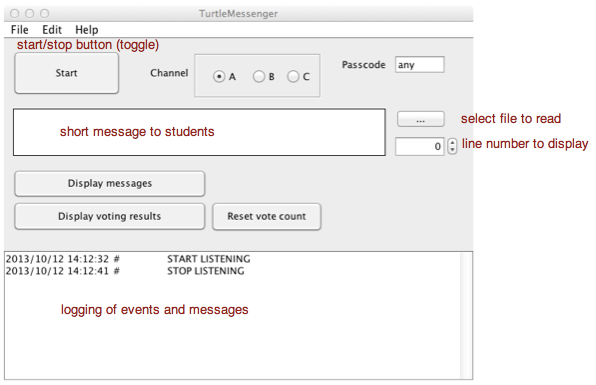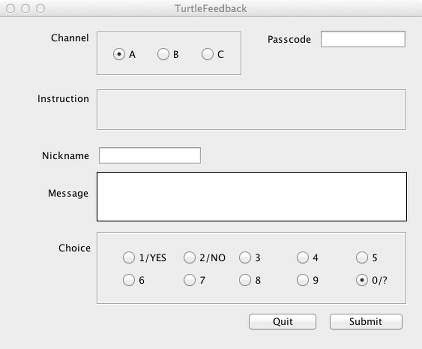TurtleMessenger
Overview
TurtleMessenger is a tool to receive responses from the students who use TurtleResponder, a software version of "clicker", in classroom.
By pressing button, TurtleMessenger start broadcasting packets to local network to notify server's IP address. TurtleResponder, software for students, receives the information to configure by itself, which means all the PCs need to be hooked up to the same sub-network to communicate each other.
TurtleMessenger also behaves as a TCP server to collect and display responses from students.
Usage
Once the main window of TurtleMessenger appears after launch, in common situations, what you need is simply to press button. The label of the button will turn to to indicate that responses are being accepted. By pressing the button again, you can stop listening packets.
In the text field just below the button, you can write a short message, within at most 250 characters, to students. The message is displayed on the window of TurtleResponder of the students' side.
Depending on your classroom environment, you might need to change the default configuration.
With "any" in passcode field (default), all the students can send responses. If you want to receive messages from limited persons, tell them a secret passcode (say, ab123) beforehand, and set the code in the field of TurtleMessenger.
If communication channel cannot be used due to some reason (e.g., in the case that other software is using the same port), try to use channel B or C, other than A. If you change the channel, let your students know the channel name. They also need to select the corresponding channel of their side.
Setting of the channel will affect the port number of TCP/UDP to be used. For channel A, port 3100 is used, for B, 3101, and, for C, 3102.

You can write a short message in the textfield below button. What you type here will be reflected on student's side immediately. You can also use text files to set the message. Press button next to the text field, then select a file to read. Only a single line in the file will be displayed at one time. By clicking the arrow, you can move to different line in the text file.
Settings on student's side
Instruct students to launch TurtleResponder (by double-clicking TurtleResponder.jar on Macs or Windows PCs). If TurtleMessenger on instructor's side is not accepting responses at this time, a warning message saying "server not found" is displayed in TurtleResponder.
If you changed passcode and/or communication channel, students need to change the corresponding item.
TurtleResponder looks like as follows:
Main window of TurtleResponder

Voting
On the window of TurtleResponder, students can select one of the radio button from 0 though 9. When they press [Submit] button, the selected item is notified to instructor's side. Button "1" is also labeled as "YES", "2" as "NO", and "0" as "?", respectively.
Selected items are automatically summarized in TurtleMessenger. To see the result, press button. Total number of voting, numbers and rations for each item will be shown, and the content is updated automatically every 2 seconds.
Press when you change question to reset the numbers.
All the responses from students are identified sender's user accounts. That is, if a student sent "1" at first, then sent "2", at the second vote, the voting count for "1" decreases AND the count for "2" increases.
By utilizing this behavior, you may figure out the progress of tasks by instructing, for example, "press 1 when you finish a half of it, 2 when you've done all."
Collecting short messages
Not only choices, but students can send short messages at most 140 characters with TurtleResponder. Students can give their nicknames.
Messages received by TurtleMessenger are listed in the Log text area in temporal order. If you want to show the message(s) on your computer display, press button. Only the messages, in which user IDs are excluded, will be displayed in another window. You can change font size, and turn on/off automatic update (every 10 secs) in the message window.
Sharing responses
By checking Enable Web access, students can read the responses made by themselves from the web browsers that they are using.
The URI to be accessed is http://IP_ADDRESS_OF_TEACHERS_PC:3080/index.html, e.g.,
http://192.168.1.123:3080/index.html.
Instruct students to click  on TurtleResponder to automatically open
the above URI while button is pressed.
on TurtleResponder to automatically open
the above URI while button is pressed.
Saving communication log
You can save the communication log in a TAB separated form to files, for example, for the purpose of reflections. The file can be opened with spreadsheet software (Excel, LibreOffice, etc) as a CSV data.
Troubleshooting
For the PCs equipped with more than one LAN interfaces (for example, Ethernet plus WiFi), broadcasting may not be treated correctly. If "server not found" message appears on student's side, choose "Broadcast" from "Settings" menu, and set the decimal values of the broadcast address for the IP subnet of your classroom. (Default broadcast address is 255.255.255.255).
If you have no idea what is the broadcast address to be set, please try to disable not using (secondary) interface, then restart TurtleMessenger.